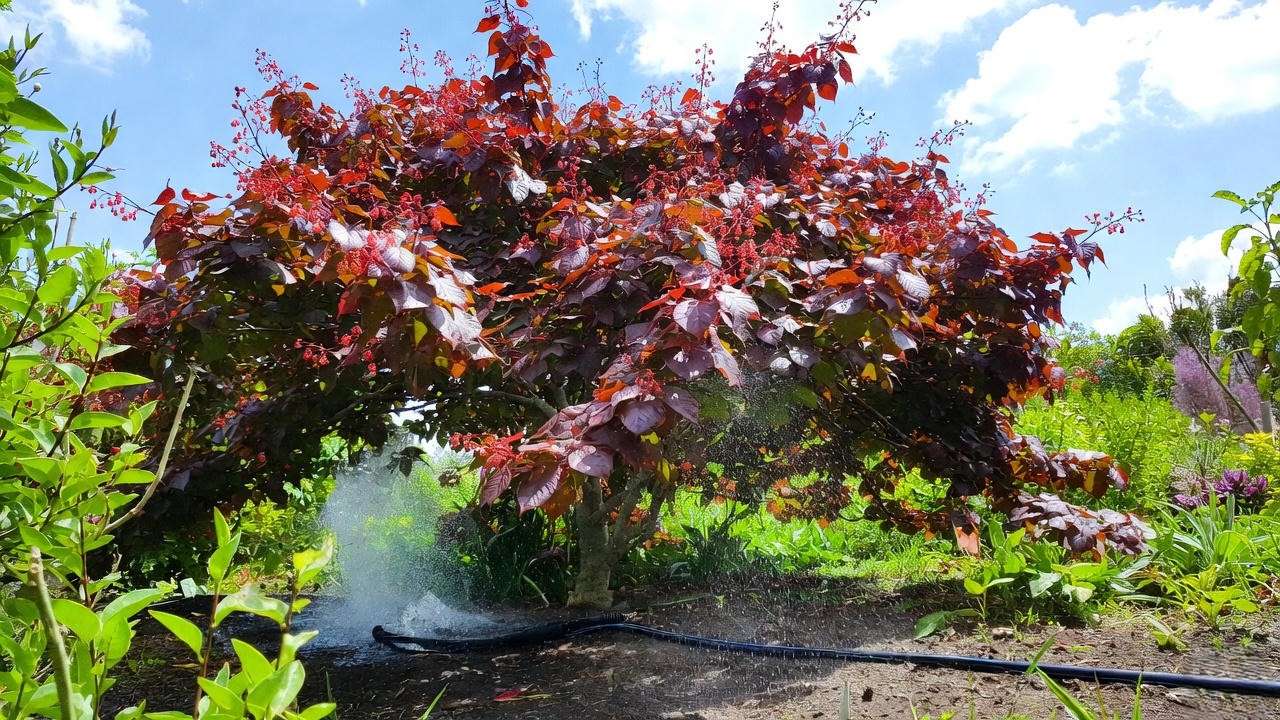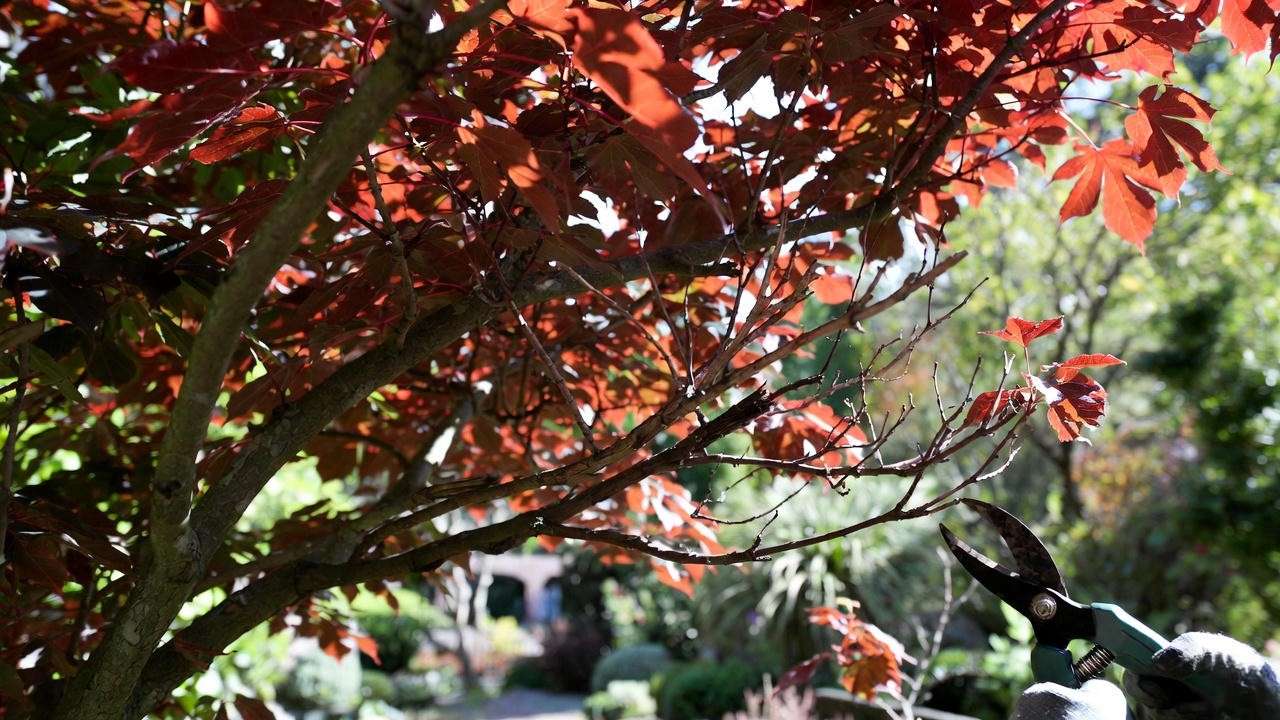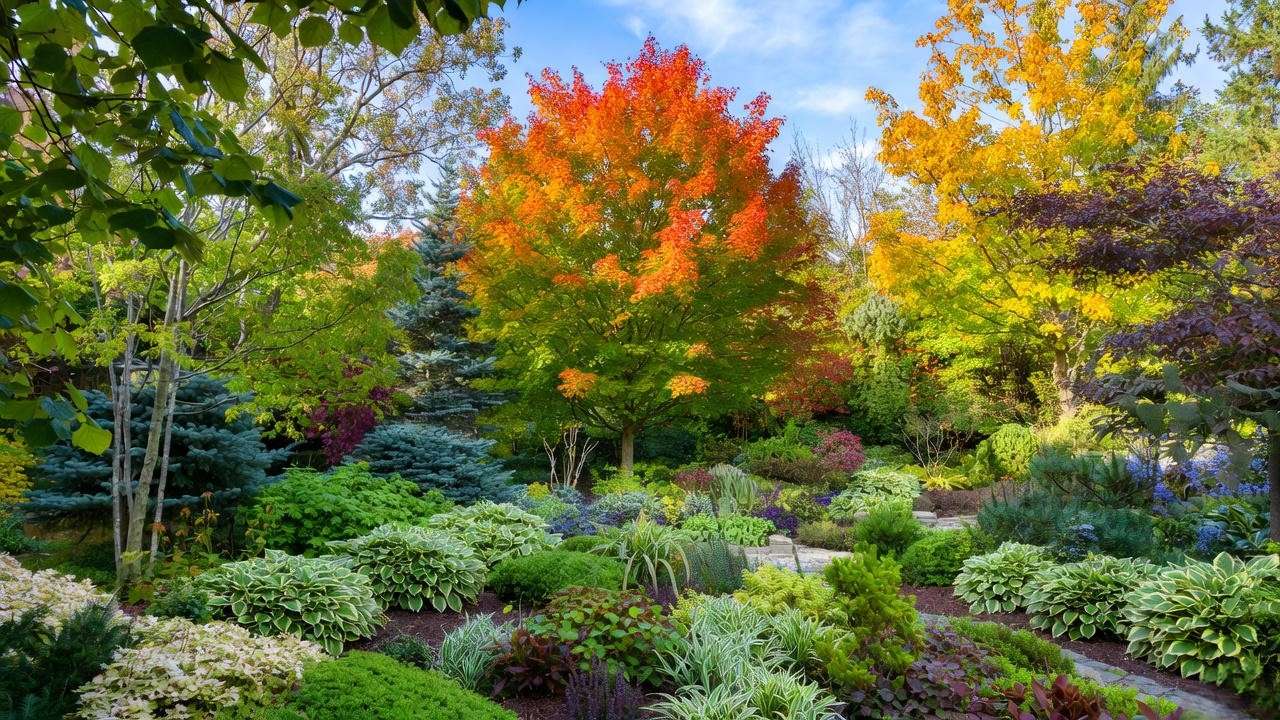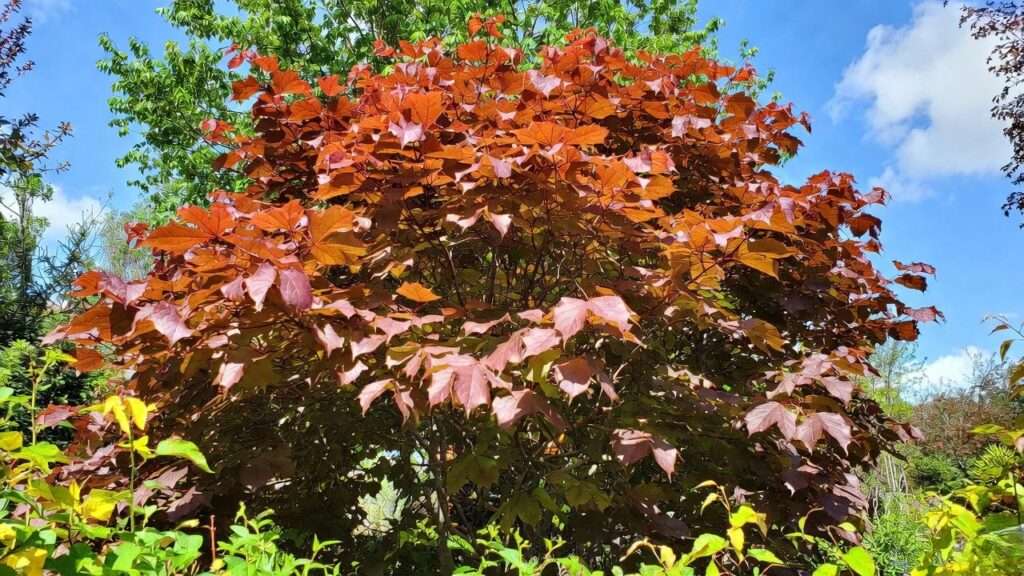Imagine a tree that sets your garden ablaze with fiery reds and oranges, stealing the show every fall. That’s the flame maple tree, a compact, vibrant star in landscaping that’s as easy to care for as it is stunning. Whether you’re a seasoned gardener or a newbie planting your first tree, mastering flame maple tree care ensures this beauty thrives for decades. In this guide, I’ll share seven expert tips—backed by my 15 years as a horticulturist—to help you nurture a healthy, dazzling flame maple. From planting to pest control, you’ll learn everything needed to solve common challenges and keep your tree glowing. Ready to make your yard the envy of the neighborhood? Let’s dive in! 🌿
H2: Understanding the Flame Maple Tree 🌿
H3: What Is a Flame Maple Tree?
The flame maple tree, often referring to Acer ginnala (Amur maple) or its hybrids, is a small deciduous tree prized for its brilliant fall foliage. Its leaves turn vivid shades of red, orange, and yellow, earning its “flame” moniker. Native to Asia, this tree grows 15-20 feet tall, making it ideal for small yards or urban settings. Its compact size, paired with a rounded canopy, suits ornamental landscaping, shade provision, or even street planting. Flame maples adapt to various climates (USDA zones 3-8) and tolerate diverse soil types, though they prefer well-drained, slightly acidic conditions. Unlike larger maples, their manageable size simplifies maintenance, perfect for homeowners seeking beauty without hassle. 🌞
H3: Why Choose a Flame Maple for Your Garden?
Why pick a flame maple over other trees? Its standout feature is the jaw-dropping fall display, rivaling even sugar maples in color intensity. Its smaller stature fits tight spaces where larger trees overwhelm. Plus, it’s low-maintenance, resisting many pests and diseases when properly cared for. Compared to red maples, flame maples grow faster and require less pruning. They’re also versatile, thriving in lawns, patios, or as privacy screens. For gardeners wanting a tree that’s both practical and show-stopping, the flame maple checks every box. 🌼
H2: Tip 1 – Selecting the Perfect Spot for Your Flame Maple 🌞
Location is everything for a thriving flame maple tree. Choose a spot with full sun (6+ hours daily) to maximize leaf color and growth. Partial shade works, but too much shade dulls the foliage. Ensure the soil drains well—flame maples hate soggy roots. Test your soil’s pH (aim for 6.0-7.0) using a home kit from your local garden center. Avoid windy areas, as strong gusts can stress young trees or snap branches.
I once helped a client in Ohio revive a struggling flame maple by relocating it from a shady, waterlogged corner to a sunny, elevated bed. Within a year, its leaves glowed like embers. Pick a site with room for the tree’s 15-20-foot spread, and you’ll set the stage for success. 🌱

H2: Tip 2 – Planting Your Flame Maple the Right Way 🌱
Planting correctly establishes a strong foundation. Spring or fall is ideal, avoiding extreme heat or frost. Dig a hole twice the width of the root ball but no deeper—planting too deep suffocates roots. Gently loosen the roots before placing the tree, ensuring the root collar sits level with the soil. Backfill with a mix of native soil and compost for nutrients. Water thoroughly, then add a 2-3-inch layer of mulch (bark or wood chips) to retain moisture, keeping it 2 inches from the trunk to prevent rot.
Avoid common errors like compacting the soil or skipping mulch. I recommend staking young trees in windy areas for the first year. With these steps, your flame maple will establish quickly and thrive. 🌿
H2: Tip 3 – Watering Wisely for a Healthy Flame Maple 💧
Watering is critical, especially for young flame maples. For the first two years, water deeply (1-2 inches) once or twice weekly, depending on rainfall. Established trees need less—water every 10-14 days during dry spells. Use a soaker hose or drip irrigation to target roots efficiently. In summer, increase frequency during heatwaves; in winter, reduce it to prevent root rot.
Watch for signs of trouble: yellowing leaves suggest overwatering, while wilting indicates thirst. A client once overwatered her flame maple, mistaking droopy leaves for dryness. After adjusting to a consistent schedule, the tree bounced back. Always check soil moisture 2 inches deep before watering. Proper hydration keeps your tree vibrant and stress-free. 🌼

H2: Tip 4 – Fertilizing for Vibrant Foliage and Strong Growth 🌼
Fertilizing boosts your flame maple’s health and color. Apply a balanced, slow-release fertilizer (10-10-10) in early spring before new growth starts. Spread it evenly around the drip line (the area under the canopy’s edge), then water well to help absorption. For a 15-foot tree, use 1-2 pounds of fertilizer, adjusting based on manufacturer guidelines.
Organic options like compost tea or fish emulsion work wonders, too. Avoid over-fertilizing—excess nitrogen causes leaf scorch or weak growth. I’ve seen gardeners revive lackluster flame maples by switching to a measured, annual feeding plan. Test your soil every 2-3 years to ensure nutrient balance, and your tree will reward you with radiant leaves. 🌿
H2: Tip 5 – Pruning for Shape and Health ✂️
Pruning keeps your flame maple shapely and healthy. The best time is late winter or early spring before buds open, minimizing stress. Use clean, sharp pruning shears or loppers to remove dead, damaged, or crossing branches. For young trees, focus on establishing a strong central leader (main trunk). Mature trees need light thinning to improve air circulation and light penetration, reducing disease risk.
Never remove more than 25% of the canopy at once, and avoid cutting flush against the trunk—leave a small collar for healing. I once reshaped a client’s overgrown flame maple, and its renewed vigor stunned them. Prune thoughtfully, and your tree will stay elegant and robust. 🌱

H2: Tip 6 – Protecting Your Flame Maple from Pests and Diseases 🐞
Flame maples are resilient, but pests and diseases can strike if you’re not vigilant. Common pests include aphids (small sap-suckers causing curled leaves), scale insects (waxy bumps on stems), and spider mites (tiny webbing creators). Check leaves and branches monthly for signs. For organic control, spray neem oil or insecticidal soap; chemical pesticides work for severe infestations but use sparingly.
Diseases like verticillium wilt (wilting branches, discolored wood), tar spot (black leaf spots), or powdery mildew (white leaf coating) are threats. Prevent them by ensuring good air circulation, avoiding overhead watering, and raking fallen leaves to reduce fungal spores. I once saved a client’s flame maple from tar spot by improving drainage and applying a fungicide early. Early detection and proper care keep your tree healthy. 🌿
H2: Tip 7 – Seasonal Care to Ensure Year-Round Beauty 🍂
H3: Spring Care
Spring is your flame maple’s growth season. Inspect for winter damage—look for cracked branches or frost-heaved roots. Fertilize as described in Tip 4, and refresh mulch to a 2-3-inch depth to conserve moisture. Prune lightly if needed, focusing on deadwood. Water consistently as new leaves emerge, especially during dry spells. A well-prepped spring sets your tree up for a vibrant year. 🌸
H3: Summer Care
Summer demands attention to watering and pests. Check soil moisture weekly, ensuring deep watering during heatwaves. Inspect for aphids or spider mites, treating promptly. Avoid fertilizing in summer—it stresses the tree. Mulch helps keep roots cool, but ensure it’s not piled against the trunk. Your flame maple’s lush canopy will shine with proper summer care. ☀️
H3: Fall Care
Fall is the flame maple’s glory season, with leaves ablaze in red and orange. Rake fallen leaves to prevent fungal diseases like tar spot. Water less as the tree prepares for dormancy, but don’t let roots dry out completely. Avoid pruning—save it for late winter. Enjoy the show, and snap photos to share your tree’s beauty! 🍁
H3: Winter Care
Winter care protects young flame maples from cold and salt damage. Wrap trunks of trees under 3 years old with burlap to shield against frost cracks. In snowy areas, gently brush heavy snow from branches to prevent breakage. Avoid de-icing salts near roots, as they burn soil. Established trees need little winter attention, but check for rodent damage. A little prep ensures spring vitality. ❄️

H2: Troubleshooting Common Flame Maple Problems 🛠️
Even with great care, issues arise. Here’s how to tackle common flame maple problems:
- Dull or faded foliage: Often due to insufficient sunlight or nutrient deficiency. Ensure 6+ hours of sun and test soil for nitrogen or iron shortages. Apply a balanced fertilizer or iron chelate as needed.
- Leaf drop or wilting: Usually caused by water stress (over- or underwatering) or pests. Check soil moisture and inspect for aphids or scale. Adjust watering and treat infestations promptly.
- Slow growth: Compacted soil, poor planting, or root competition may be culprits. Aerate soil, ensure proper planting depth, and remove nearby weeds or grass.
If problems persist, consult a certified arborist. I’ve seen many flame maples recover with targeted fixes, like a tree I revived by correcting overwatering and adding compost. Stay proactive, and your tree will thrive. 🌳
H2: Enhancing Your Landscape with Flame Maple Trees 🎨
Flame maples are landscaping superstars. Use them as focal points in lawns, where their fall colors pop against green grass. Line walkways or driveways for a dramatic seasonal display. In small yards, plant dwarf varieties like Acer ginnala ‘Compactum’ or grow them in large containers for patios. Pair with evergreens like junipers or low-growing shrubs like spirea for contrast. Hostas and ferns complement their shade-tolerant understory.
For urban gardens, flame maples work as street trees, provided they’re protected from salt and pollution. I designed a client’s backyard around a flame maple centerpiece, and it transformed the space into a fall spectacle. Get creative—your landscape will thank you! 🌼

H2: FAQs About Flame Maple Tree Care ❓
Q1: How fast does a flame maple tree grow? A: Flame maples grow moderately fast, adding 1-2 feet per year under ideal conditions. Full maturity takes 10-15 years, reaching 15-20 feet.
Q2: Can flame maples tolerate drought? A: Once established, they handle short droughts but prefer consistent moisture. Water deeply during prolonged dry spells to maintain health.
Q3: Are flame maple trees invasive? A: Amur maples (Acer ginnala) can self-seed in some regions, potentially becoming invasive. Check local regulations and remove seedlings to control spread.
Q4: How do I boost the red color of my flame maple’s leaves? A: Ensure full sun, balanced soil nutrients, and avoid overwatering. Stress from slight drought in late summer can enhance red hues.
Q5: What’s the lifespan of a flame maple tree? A: With proper care, flame maples live 60-80 years, sometimes longer in optimal conditions.
Word count: ~250 words
Conclusion: Your Flame Maple, Thriving for Years to Come 🌈
With these seven expert tips—site selection, proper planting, smart watering, fertilizing, pruning, pest control, and seasonal care—your flame maple tree will flourish, dazzling your yard with fiery foliage year after year. As a horticulturist, I’ve seen countless trees transform landscapes when given the right care. Apply these strategies, and you’ll solve common challenges while ensuring long-term health. Have questions or want to share your flame maple’s progress? Drop a comment below or explore our other tree care guides for more expert advice. Here’s to a vibrant, thriving flame maple that lights up your garden! 🌳













